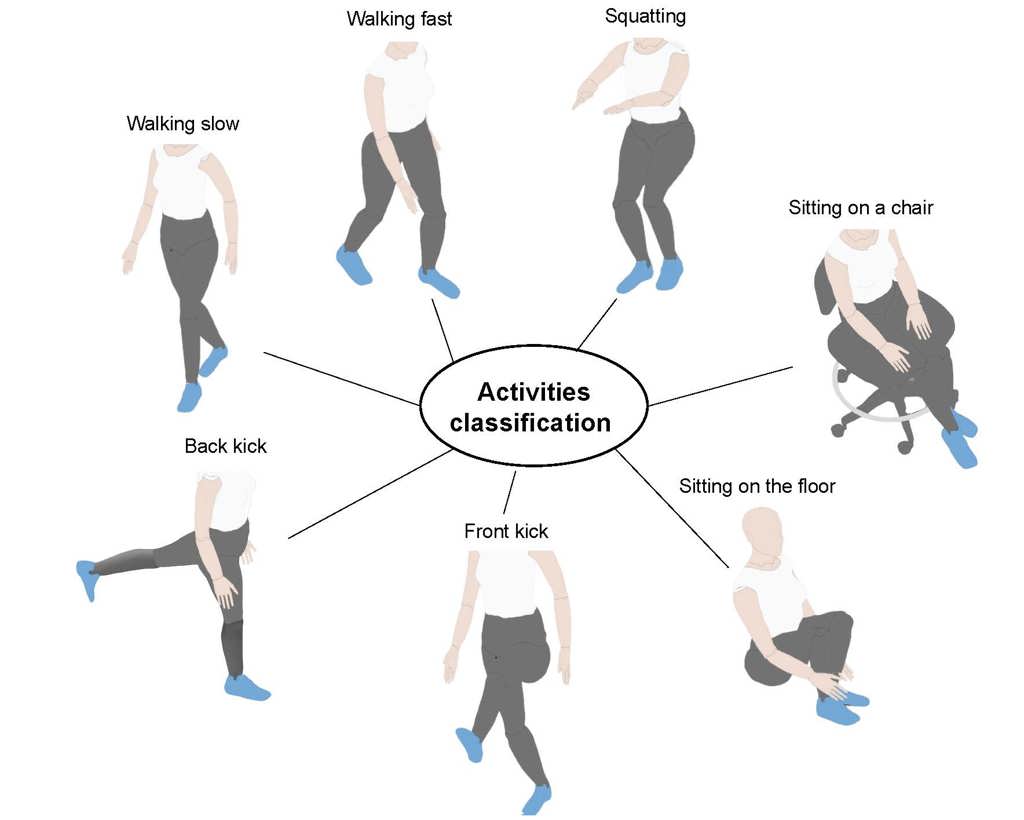About
27 June 2023
Fiber optic smart pants offer a low-cost way to monitor movements
New smart textiles could be used to track various types of physical activities in the clinic or at home

Caption: Researchers have developed smart pants that use fiber optic sensors to non-invasively track a person’s movements and activities. They detect 30 measurement points on each leg.
Credit: Arnaldo Leal-Junior, Federal University of Espirito Santo
WASHINGTON —With an aging global population comes a need for new sensor technologies that can help clinicians and caregivers remotely monitor a person’s health. New smart pants based on fiber optic sensors could help by offering a nonintrusive way to track a person’s movements and issue alerts if there are signs of distress.
“Our polymer optical fiber smart pants can be used to detect activities such as sitting, squatting, walking or kicking without inhibiting natural movements,” said research team leader Arnaldo Leal-Junior from the Federal University of Espirito Santo in Brazil. “This approach avoids the privacy issues that come with image-based systems and could be useful for monitoring aging patients at home or measuring parameters such as range of motion in rehabilitation clinics.”
In the Optica Publishing Group journal Biomedical Optics Express, the researchers describe the new smart pants, which feature transparent optical fibers directly integrated into the textile. They also developed a portable signal acquisition unit that can be placed inside the pants pocket.
“This research shows that it is possible to develop low-cost wearable sensing systems using optical devices,” said Leal-Junior. “We also demonstrate that new machine learning algorithms can be used to extend the sensing capabilities of smart textiles and possibly enable the measurement of new parameters.”
Creating fiber optic pants
The research is part of a larger project focused on the development of photonic textiles for low-cost wearable sensors. Although devices like smartwatches can tell if a person is moving, the researchers wanted to develop a technology that could detect specific types of activity without hindering movement in any way. They did this by incorporating intensity variation polymer optical fiber sensors directly into fabric that was then used to create pants.
The sensors were based on polymethyl methacrylate optical fibers that are 1 mm in diameter. The researchers created sensitive areas in the fibers by removing small sections of the outer cladding fiber core. When the fiber bends due to movement, this will cause a change in optical power traveling through the fiber and can be used to identify what type of physical modification was applied to the sensitive area of the fiber.
By creating these sensitive fiber areas in various locations, the researchers created a multiplexed sensor system with 30 measurement points on each leg. They also developed a new machine learning algorithm to classify different types of activities and to classify gait parameters based on the sensor data.

Caption: The smart pants were able to detect when a person was performing various activities, including slow walking, fast walking, squatting, sitting on a chair, sitting on the floor, front kick and back kick.
Credit: Arnaldo Leal-Junior, Federal University of Espirito Santo
Classifying activities
To test their prototype, the researchers had volunteers wear the smart pants and perform specific activities: slow walking, fast walking, squatting, sitting on a chair, sitting on the floor, front kicking and back kicking. The sensing approach achieved 100% accuracy in classifying these activities.
“Fiber optic sensors have several advantages, including the fact that they are immune to electric or magnetic interference and can be easily integrated into different clothing accessories due to their compactness and flexibility,” said Leal-Junior. “Basing the device on a multiplexed optical power variation sensor also makes the sensing approach low-cost and highly reliable.”
The researchers are now working to connect the signal acquisition unit to the cloud, which would enable the data to be accessed remotely. They also plan to test the smart textile in home settings.
This work was performed in LabSensors/LabTel in the scope of assistive technologies framework funded by Brazilian agencies FINEP and CNPq.
Paper: L. Avellar, A. Frizera, A. Leal-Junior, “POF Smart Pants - A fully portable optical fiber-integrated smart textile for remote monitoring of lower limb biomechanics,” Biomed. Opt. Express,Vol. 14, Issue 7, pp. 3689-3704 (2023).
DOI: https://doi.org/10.1364/BOE.492796
About Optica Publishing Group
Optica Publishing Group is a division of the society, Optica, Advancing Optics and Photonics Worldwide. It publishes the largest collection of peer-reviewed and most-cited content in optics and photonics, including 18 prestigious journals, the society’s flagship member magazine, and papers and videos from more than 835 conferences. With over 400,000 journal articles, conference papers and videos to search, discover and access, our publications portfolio represents the full range of research in the field from around the globe.
About Biomedical Optics Express
Biomedical Optics Express serves the biomedical optics community with rapid, open-access, peer-reviewed papers related to optics, photonics and imaging in biomedicine. The journal scope encompasses fundamental research, technology development, biomedical studies and clinical applications. It is published monthly by Optica Publishing Group and edited by Christoph Hitzenberger, Medical University of Vienna, Austria. For more information, visit Biomedical Optics Express.
Media Contact
